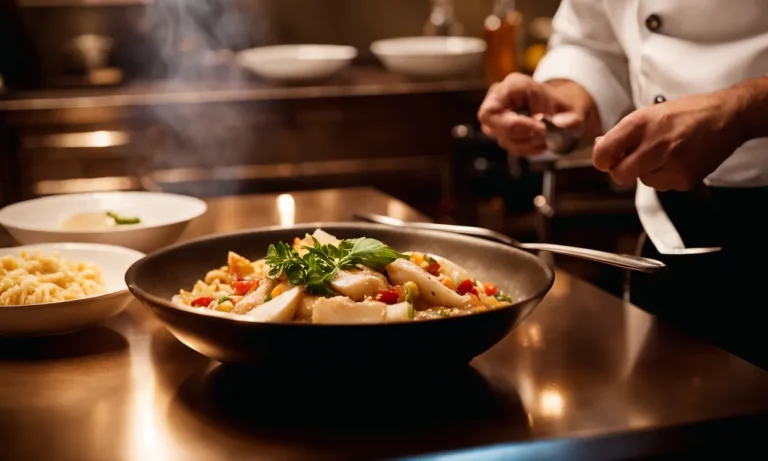Matcha green tea lattes have become an iconic drink from Starbucks that many people love. If you’ve ever wondered how to recreate that earthy, creamy, slightly sweet matcha flavor at home, you’ve come to the right place.
If you’re short on time, here’s a quick answer to your question: Use 2 tsp of high quality matcha powder, add hot water and whisk into a smooth paste. Add steamed milk and sweetener if desired. The key is using real matcha powder and whisking it well before adding the milk.
In this comprehensive guide, we’ll go over everything you need to know to make an authentic matcha latte just like you’d get at Starbucks. You’ll learn the basics about matcha and its health benefits, the essential ingredients and ratios to use, step-by-step instructions and tips for making it, and some delicious customizations you can try.
What is Matcha?
Matcha, a traditional Japanese green tea, has gained popularity worldwide for its unique flavor and health benefits. Unlike regular green tea, matcha is made from shade-grown tea leaves that are finely ground into a vibrant green powder.
This powder is then whisked into hot water or milk to create a frothy and invigorating beverage.
Basic definition
Matcha comes from the Camellia sinensis plant, just like other types of tea. However, what sets matcha apart is the way it is grown and prepared. The tea bushes are shaded for several weeks before harvest, which increases the chlorophyll content and gives matcha its vibrant green color.
After harvesting, the leaves are steamed, dried, and ground into a fine powder.
Caffeine and antioxidant content
Matcha contains caffeine, but in lower amounts compared to coffee. However, the unique combination of caffeine and other natural compounds, such as L-theanine, gives matcha a calm and focused energy boost.
L-theanine promotes relaxation without causing drowsiness, making matcha a popular choice for those seeking a gentler caffeine experience.
In addition to caffeine, matcha is packed with antioxidants called catechins. These powerful compounds help protect the body against free radicals, which are unstable molecules that can damage cells and contribute to chronic diseases.
In fact, matcha has been found to contain higher levels of catechins compared to other types of green tea.
Health benefits
Drinking matcha has been associated with several health benefits. The high antioxidant content in matcha may help reduce the risk of chronic diseases, such as heart disease and certain types of cancer.
Matcha has also been shown to boost metabolism and promote weight loss, making it a popular choice among those looking to shed a few pounds.
Moreover, matcha is known for its calming properties. The combination of L-theanine and caffeine in matcha can promote a state of relaxed alertness, helping to reduce stress and improve mental clarity.
This is why matcha has been used in traditional Japanese tea ceremonies as a means of meditation and mindfulness.
It’s important to note that while matcha offers many health benefits, it should be consumed in moderation as part of a balanced diet. As with any food or beverage, it’s best to consult with a healthcare professional if you have any specific health concerns or conditions.
If you want to learn more about matcha and its benefits, you can visit Healthline or NCBI for authoritative information and research studies on matcha.
Essential Ingredients for Matcha Latte
Matcha green tea powder
One of the key ingredients in making a delicious matcha latte is high-quality matcha green tea powder. Matcha is a finely ground powder made from specially grown and processed green tea leaves. It has a vibrant green color and a unique, slightly bitter taste.
To ensure you’re getting the best matcha powder, look for ones that are made from shade-grown tea leaves and are certified organic. You can find matcha powder at specialty tea shops or online retailers.
Hot water
Hot water is needed to whisk the matcha powder into a smooth and frothy consistency. The water should be heated to around 175°F (80°C) to preserve the flavor and nutrients of the matcha. Be careful not to use boiling water as it can scorch the delicate taste of the tea.
If you don’t have a thermometer, simply bring the water to a gentle simmer and let it cool for a minute before using.
Milk
Milk is an essential component of a matcha latte as it adds creaminess and balances out the bitterness of the tea. You can use any type of milk you prefer, such as dairy milk, almond milk, oat milk, or soy milk.
Each type of milk will impart a slightly different flavor profile to your latte, so feel free to experiment and find your favorite combination. For a traditional matcha latte, whole milk or a milk alternative with a creamy texture works best.
Sweetener (optional)
If you prefer a sweeter taste, you can add a sweetener of your choice to your matcha latte. Common sweeteners used include honey, maple syrup, agave nectar, or simple syrup. Start with a small amount and adjust to your desired level of sweetness.
Keep in mind that matcha already has a natural sweetness, so you may not need much additional sweetener. It’s best to taste and adjust as you go to find the perfect balance.
Matcha to Water Ratio
When it comes to making a delicious matcha green tea latte like Starbucks, getting the right matcha to water ratio is crucial. This will ensure that you achieve the perfect balance of flavors and a smooth, creamy texture in your latte.
Let’s take a look at the standard proportions and how you can adjust them to suit your personal taste.
Standard proportions
The standard matcha to water ratio for a latte is about 1 teaspoon of matcha powder to 6 ounces of hot water. This ratio allows the matcha flavor to shine through without overpowering the other ingredients.
It’s important to note that the water should be hot but not boiling, as boiling water can make the matcha taste bitter.
To make your latte, start by sifting the matcha powder into a bowl to remove any clumps. Then, add a small amount of hot water and whisk vigorously in a zigzag motion until the matcha is fully dissolved and frothy.
Finally, add your choice of milk and sweetener to taste, and enjoy your homemade matcha latte!
Adjusting to taste
If you prefer a stronger matcha flavor, you can increase the amount of matcha powder in your latte. Try using 1.5 teaspoons or even 2 teaspoons of matcha for 6 ounces of water. Keep in mind that increasing the matcha powder may result in a slightly more bitter taste, so you might want to add a bit more sweetener to balance it out.
On the other hand, if you find the matcha flavor too strong or overpowering, you can decrease the amount of matcha powder in your latte. Start by using 3/4 or 1/2 teaspoon of matcha for 6 ounces of water and adjust to your liking.
This will give you a milder matcha flavor that allows the other ingredients to shine through.
Remember, finding the perfect matcha to water ratio is a matter of personal preference. Don’t be afraid to experiment and tweak the proportions until you find the taste that you love. After all, making your own matcha green tea latte is all about enjoying a customized beverage that suits your unique palate.
Step-by-Step Instructions
Sift matcha powder
To start making your own matcha green tea latte like Starbucks, the first step is to sift the matcha powder. This will help remove any lumps and ensure a smooth and creamy texture in your drink. Using a fine-mesh sieve or a matcha sifter, gently tap the powder into a bowl, making sure to break up any clumps that may be present.
Add hot water and whisk
Next, add hot water to the bowl containing the sifted matcha powder. The water should be just below boiling point. Using a bamboo whisk or a small whisk, vigorously whisk the matcha powder and hot water together in a zig-zag motion.
This will help to fully dissolve the powder and create a frothy mixture.
Froth milk
While the matcha is whisking, you can froth your milk. You can use any type of milk you prefer, such as dairy milk, almond milk, or oat milk. Heat the milk in a small saucepan over medium heat until it reaches your desired temperature.
Then, use a handheld milk frother or a whisk to create a nice froth on the surface of the milk.
Combine matcha and milk
Once your matcha and milk are ready, pour the frothed milk into the bowl with the matcha mixture. Gently stir the two together until well combined. This will create a creamy and velvety texture in your matcha green tea latte.
Sweeten if desired
If you prefer your matcha green tea latte to be sweeter, you can add a sweetener of your choice. Some popular options include honey, agave syrup, or vanilla syrup. Start with a small amount and taste as you go, adding more sweetener if needed.
Remember that matcha has a naturally bitter taste, so be mindful not to overpower it with sweetness.
Toppings
To add a finishing touch to your matcha green tea latte, you can get creative with toppings. Some popular options include whipped cream, a dusting of matcha powder, or a sprinkle of cinnamon. You can also experiment with adding flavored syrups or a drizzle of chocolate sauce.
Get creative and make your matcha latte truly your own!
For more information on matcha and its health benefits, you can visit Healthline.
Tips and Tricks
Buying high quality matcha
When making a Matcha Green Tea Latte like Starbucks, it is crucial to start with high quality matcha powder. Look for matcha that is vibrant green in color, as this indicates freshness. Avoid matcha that is dull or brownish, as it may have lost its flavor and nutritional value.
It is also recommended to buy matcha from reputable sources or specialty tea shops to ensure you are getting the best quality.
Water temperature
The water temperature plays a significant role in the taste and texture of your latte. For matcha, it is best to use water that is around 175°F (80°C). Boiling water can scorch the matcha and result in a bitter taste.
To achieve the perfect water temperature, you can heat the water until it reaches a simmer, then let it cool for a minute or two before mixing it with the matcha powder.
Type of milk
The type of milk you use can greatly impact the flavor and creaminess of your Matcha Green Tea Latte. While Starbucks typically uses whole milk, you can experiment with different types of milk depending on your preference. Some popular options include almond milk, oat milk, and coconut milk.
These alternatives can add unique flavors and create a dairy-free version of the latte. Feel free to choose the one that suits your taste and dietary needs.
Storage
To maintain the freshness of your matcha powder, it is important to store it correctly. Matcha is highly sensitive to air, light, and moisture, which can degrade its quality. After opening the package, transfer the matcha powder to an airtight container and store it in a cool, dark place.
Avoid storing it in the refrigerator, as the moisture can cause clumping. Proper storage will ensure that your matcha stays fresh and flavorful for longer.
Reusing matcha pulp
After whisking your matcha powder with hot water, you may be left with a small amount of pulp at the bottom of your bowl. Instead of discarding it, you can find creative ways to reuse the matcha pulp. One option is to mix it into your smoothies or baked goods for an added boost of antioxidants and flavor.
You can also sprinkle it on top of yogurt or oatmeal for a vibrant and nutritious touch. Don’t let any bit of matcha go to waste!
Customizations
Flavored syrups
One of the best things about making a matcha green tea latte at home is the ability to customize it to your taste. If you’re a fan of flavored syrups, you can add a pump or two of your favorite syrup to your latte to give it an extra burst of flavor.
Popular choices include vanilla, caramel, and hazelnut syrups. These syrups can be found at most grocery stores or specialty coffee shops. Simply add them to your matcha green tea latte after whisking in the matcha powder and sweetener.
Spices
If you’re looking to add a little spice to your matcha green tea latte, there are plenty of options to choose from. A dash of cinnamon or nutmeg can give your latte a warm and cozy flavor. Alternatively, you can try adding a pinch of ginger or cardamom for a unique twist.
Experiment with different spices to find your perfect combination. Just remember, a little goes a long way, so start with a small amount and adjust to taste.
Alternative milks
For those who are lactose intolerant or prefer non-dairy options, there are many alternative milks available that can be used in a matcha green tea latte. Some popular choices include almond milk, soy milk, and oat milk.
These milks can be found at most grocery stores and provide a creamy and smooth texture to your latte. Experiment with different milks to find the one that suits your taste preferences. You can even try blending different milks for a unique flavor combination.
Conclusion
With this comprehensive guide, you have all the information you need to start making authentic matcha lattes at home that rival your favorite coffee shop. It may take some experimenting to get the ratios and preparation method just right for your taste.
But once you nail it down, this special drink can become part of your daily self-care routine. Drink up and enjoy all the antioxidants, focus, and calm energy that matcha lattes have to offer!






